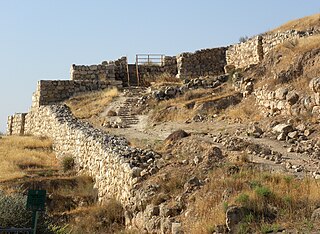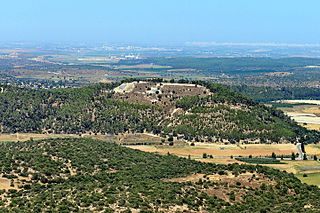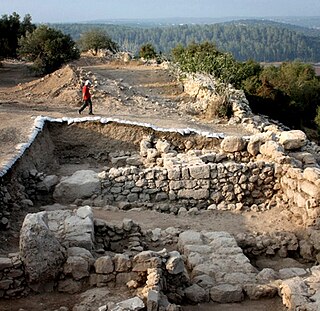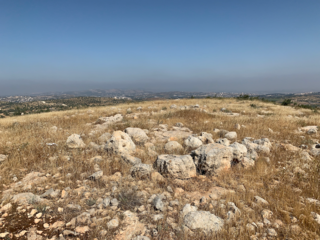
David was, according to the Hebrew Bible, the third king of the United Kingdom of Israel. Historians of the Ancient Near East agree that David probably lived around 1000 BCE, but little more is known about him as a historical figure.

The history of ancient Israel and Judah begins in the Southern Levant region of Western Asia during the Late Bronze Age and Early Iron Age. "Israel" as a people or tribal confederation appears for the first time in the Merneptah Stele, an inscription from ancient Egypt that dates to about 1208 BCE, with the people group possibly being older. According to modern archaeology, ancient Israelite culture developed as an outgrowth from the Semitic Canaanites. Two related Israelite polities known as the Kingdom of Israel (Samaria) and the Kingdom of Judah had emerged in the region by Iron Age II.

The Kingdom of Judah was a Semitic-speaking kingdom of the Southern Levant during the Iron Age. Centered in the highlands of Judea, the kingdom's capital was Jerusalem. Jews are named after Judah and are primarily descended from it.
Ziklag is the biblical name of a town that was located in the Negev region in the south-west of what was the Kingdom of Judah. It was a provincial town within the Philistine kingdom of Gath when Achish was king. Its exact location has not been identified with any certainty.

Lachish was an ancient Canaanite and Israelite city in the Shephelah region of Israel, on the south bank of the Lakhish River, mentioned several times in the Hebrew Bible. The current tell (ruin) by that name, known as Tel Lachish or Tell ed-Duweir ,, has been identified with the biblical Lachish. Today, it is an Israeli national park operated and maintained by the Israel Nature and Parks Authority. The park was established on lands of the depopulated Palestinian village of Qobebet Ibn ‘Awwad which was north of the Tel. It lies near the present-day moshav of Lakhish.

Israel Finkelstein is an Israeli archaeologist, professor emeritus at Tel Aviv University and the head of the School of Archaeology and Maritime Cultures at the University of Haifa. Finkelstein is active in the archaeology of the Levant and is an applicant of archaeological data in reconstructing biblical history. He is also known for applying the exact and life sciences in archaeological and historical reconstruction. Finkelstein is the current excavator of Megiddo, a key site for the study of the Bronze and Iron Ages in the Levant.

Brook of Egypt is the name used in some English translations of the Bible for the Hebrew נַחַל מִצְרַיִם, naḥal mizraim, a river (bed) forming the southernmost border of the Land of Israel. A number of scholars in the past identified it with Wadi El-Arish, an epiphemeral river flowing into the Mediterranean sea near the Egyptian city of Arish, while other scholars, including Israeli archaeologist Nadav Na'aman and the Italian Mario Liverani believe that the Besor stream, just to the south of Gaza, is the "Brook of Egypt" referenced in the Bible. A related phrase is nahar mizraim, used in Genesis 15:18.

Azekah was an ancient town in the Shfela guarding the upper reaches of the Valley of Elah, about 26 km (16 mi) northwest of Hebron.

The Tel Dan Stele is a fragmentary stele containing a Canaanite inscription which dates to the 9th century BCE. It is notable for possibly being the most significant and perhaps the only extra-biblical archeological reference to the house of David.

LMLK seals are ancient Hebrew seals stamped on the handles of large storage jars first issued in the reign of King Hezekiah and discovered mostly in and around Jerusalem. Several complete jars were found in situ buried under a destruction layer caused by Sennacherib at Lachish. While none of the original seals have been found, some 2,000 impressions made by at least 21 seal types have been published. The iconography of the two and four winged symbols are representative of royal symbols whose meaning "was tailored in each kingdom to the local religion and ideology".

The United Monarchy is a political entity described in the deuteronomistic history of the Hebrew Bible as, under the reigns of Saul, David, and Solomon, encompassing the territories of both the later Kingdom of Judah and Samarian Kingdom of Israel. Whether the United Monarchy actually existed is a matter of ongoing academic debate, and scholars remain divided between those who support the historicity of the biblical narrative, those who doubt or dismiss it, and those who support the kingdom's theoretical existence while maintaining that the biblical narrative is exaggerated. Proponents of the kingdom's existence traditionally date it to between c. 1047 BCE and c. 930 BCE.

The Millo was a structure in Jerusalem referred to in the Hebrew Bible, first mentioned as being part of the city of David in 2 Samuel 5:9 and the corresponding passage in the Books of Kings and later in the Books of Chronicles. However it previously seems to have been a rampart built by the Jebusites prior to Jerusalem's being conquered by the Israelites. The texts also describe the Millo built by Solomon and repaired by Hezekiah, without giving an explanation of what exactly the Millo was: there is therefore some debate among scholars as to the Millo's specific nature. The most common assumption among archaeologists and historians of ancient Israel is that the Millo is the Stepped Stone Structure uncovered by Kathleen Kenyon and demonstrated by Eilat Mazar to be connected to a Large Stone Structure which she discovered in 2005.

Khirbet Qeiyafa, also known as Elah Fortress and in Hebrew as Horbat Qayafa, is the site of an ancient fortress city overlooking the Elah Valley and dated to the first half of the 10th century BCE. The ruins of the fortress were uncovered in 2007, near the Israeli city of Beit Shemesh, 30 km (20 mi) from Jerusalem. It covers nearly 2.5 ha and is encircled by a 700-meter-long (2,300 ft) city wall constructed of stones weighing up to eight tons each. Excavations at site continued in subsequent years. A number of archaeologists, mainly the two excavators, Yosef Garfinkel and Saar Ganor, have claimed that it might be one of two biblical cities, either Sha'arayim, whose name they interpret as "Two Gates", because of the two gates discovered on the site, or Neta'im; and that the large structure at the center is an administrative building dating to the reign of King David, where he might have lodged at some point. This is based on their conclusions that the site dates to the early Iron IIA, ca. 1025–975 BCE, a range which includes the biblical date for the biblical Kingdom of David. Others suggest it might represent either a North Israelite, Philistine, or Canaanite fortress, a claim rejected by the archaeological team that excavated the site. The team's conclusion that Khirbet Qeiyafa was a fortress of King David has been criticised by some scholars.

Yosef Garfinkel is an Israeli archaeologist and academic. He is Professor of Prehistoric Archaeology and of Archaeology of the Biblical Period at the Hebrew University of Jerusalem.
Saar Ganor is an Israeli archaeologist. He was the director, along with Yosef Garfinkel, of excavations at Khirbet Qeiyafa, thought to be Biblical Sha'arayim. He is inspector for the Israel Antiquities Authority and a lecturer at the Hebrew University of Jerusalem.

According to the First Book of Kings and the Second Book of Chronicles of the Hebrew Bible, Jeroboam's Revolt was an armed insurrection against Rehoboam, king of the United Monarchy of Israel, and subsequently the Kingdom of Judah, led by Jeroboam in the late 10th century BCE. The conflict, referring to the independence of the Kingdom of Samaria and the subsequent civil war during Jeroboam's rule, is said to have begun shortly after the death of Solomon lasting until the Battle of Mount Zemaraim. The conflict began due to discontent under the rule of Solomon's successor, his son Rehoboam, and was waged with the goal of breaking away from the United Monarchy of Israel. Though this goal was achieved very early on in the conflict, the war continued throughout the duration of Rehoboam's reign and well into the reign of his son, Abijam, who defeated the armies of Jeroboam but failed to reunite the kingdoms.

The so-called Bull Site at Dhahrat et-Tawileh, also spelled Daharat et-Tawileh, in the West Bank is an open air ancient cult installation from 12th-century BCE Canaan, where the bronze statuette of a bull was found. There is agreement that the statuette represents a sacred bull, but which god was represented by it is unclear. The statuette has been associated with the god Baal.

The Khirbet Qeiyafa ostracon is a 15-by-16.5-centimetre ostracon with five lines of text, discovered in Building II, Room B, in Area B of the excavations at Khirbet Qeiyafa in 2008. Hebrew University archaeologist Amihai Mazar said the inscription was the longest Proto-Canaanite text ever found. Carbon-14 dating of 4 olive pips found in the same context with the ostracon and pottery analysis offer a date of Iron Age IIA c. 3,000 years ago.

Khirbet er-Ra'i, also Khirbet al-Ra'i, is an archaeological site in the Shephelah region of Israel. It is located 4 km west of Lachish.
Nadav Na'aman is an Israeli archaeologist and historian. He specializes in the study of Near East in the second and first millenniums BC. His research combines the history of the Ancient Near East, archaeology, Assyrology, and the study of the Bible. He possesses broad knowledge in all these four branches of research.

















